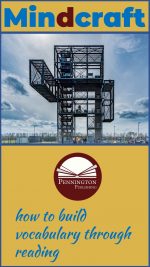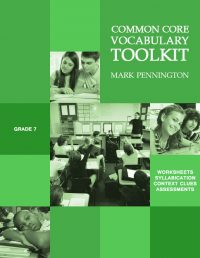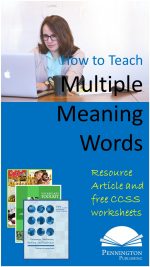Build Vocabulary through Reading
The reading research certainly supports direct vocabulary instruction: According to the National Reading Panel (2000), explicit instruction of vocabulary is highly effective in improving reading comprehension. “Students should be explicitly taught both specific words and word-learning strategies. To deepen students’ knowledge of word meanings, specific word instruction should be robust” (Beck et al., 2002). In fact, the vocabulary standards delineated in the Common Core Anchor Standards for Language mention each of these explicit areas of vocabulary instruction.
- Multiple Meaning Words and Context Clues (L.4.a.)
- Greek and Latin Word Parts (L.4.a.)
- Language Resources (L.4.c.d.)
- Figures of Speech (L.5.a.)
- Word Relationships (L.5.b.)
- Connotations (L.5.c.)
- Academic Language Words (L.6.0)
Teaching to these vocabulary standards will enrich your students depth of vocabulary knowledge and will teach your students how language and words help us learn. And reading research indicates that students can learn some 400 words per year in school through explicit vocabulary instruction (Beck, McKewon & Kucan, 2002).
However,
Numerous studies have estimated that students need to learn from 2,000–4,000 new words per year to make grade to grade reading growth. The most widely cited study indicates that students need to learn 3,000 new words per year (Honig 1983).
So, if the vocabulary standards help students master 400 words per year, how can we ensure that students learn the additional 2,600 words needed to make at least one grade level of reading growth in our classrooms? The Common Core authors discuss this solution in Appendix A of the CCSS document. So, what is this key instructional strategy that will help your students meet and exceed that goal of 3,000 new words per year?
Independent reading.

Comprehensive Vocabulary
Let’s do the math. When reading at independent levels (around 95% word recognition*), that means that students are exposed to 5% unknown words. Reading at an average 200 words per minute, 30 minutes per day, 4 days per week, means that students will read 864,000 words during the school year. If 5% of these words are unknown to the reader and the reader masters 10%** of those unknown words, this results in a gain of not 3,000, but 4,320 new vocabulary words! (30 minutes x 200 words = 6,000 x 4 days per week = 24,000 x 36 weeks = 864,000 words read in a year x 5% unknown words = 43,200 x 10% mastery =4,320.
Now, having been convinced regarding the efficacy of building vocabulary through independent reading, let’s not jump to the same conclusions that some advocates of the “whole language” approach to reading made during the 1980s and 1990s and the “balanced literature” adherents make today: If incidental vocabulary acquisition through wide reading produces a greater number of new words (4,320 in our example) than does explicit vocabulary instruction (400), let’s abandon explicit vocabulary instruction altogether.
This conclusion is flawed. Consider this question: What is it that allows the reader to mastery 10% of the 5% unknown words when reading text at optimal word recognition levels? It’s precisely the vocabulary strategies that readers internalize through explicit instruction and practice. For example, numerous studies suggest that using instructional strategies that teach students how to use context clues effectively can improve that 10% mastery of unknown words (Rhoder and Huerster, 2002, Greenwood and Flanigan, 2007). Additionally, explicit instruction in Greek and Latin word parts which appear in 50% of Tier 2 academic vocabulary can provide the structural clues to significantly improve that 10% number. Clearly, studying non-contextual vocabulary can improve the efficiency of readers to understand and master contextual vocabulary in reading.
Bottom line: Students need both explicit vocabulary instruction (those Common Core grade-level vocabulary standards) and enough independent reading to make at least one grade level of reading progress.
But, how can we be sure that it’s independent reading that teaches the most vocabulary? Don’t students learn vocabulary naturally through listening throughout their school day and at home? Don’t students get plenty of reading throughout the day in literature, science, and social studies texts? Way back in 1988, reading researchers Hayes and Athens published interesting research regarding this question. They counted the number of words above the 1,000 highest frequency words (usually mastered by most primary grade students) for a variety of listening venues such as adult-level conversations, court cases, and the nightly news. As an example, watching and listening to the nightly news exposes the viewer/listener to only 19 of these key words. In contrast, reading for the same amount of time provides a much higher exposure to words beyond the most frequently used 1,000 words. For example, reading a challenging comic book for the same amount of time exposes the reader to 53 of these challenging words. Reading a challenging book for the same amount of time exposes a reader to 75. Unfortunately, research indicates that the amount students read in a school day through teacher-directed reading tasks is miminal. Clearly, independent reading is the most efficient means of learning new words, when supported by explicit vocabulary instruction.
When should students complete their independent reading?
Many teachers buy into the research on the value of independent reading and provide in-class time for sustained silent reading. However, my take is that independent reading in class is largely both inefficient and reductive.
Again, taking a look at the math, few teachers (other than “The Book Whisperer”) at the elementary, middle, and high school levels would be willing or even permitted to allocate the 120 minutes per week of class time necessary to achieve optimal vocabulary growth. In a typical secondary ELA class with 200 minutes of instructional time per week (less with holidays and all-too-frequent instructional interruptions), the 120 minutes would take up more than half of available instructional time. Few principals would permit this encroachment upon teaching grade-level standards. As one of my own principals once told our middle school ELA department, “The district is not paying you to babysit students doing independent reading. Earn your paychecks!” The principal’s statements were a trifle blunt, but essentially correct that all instructional time is reductive. You can’t add something without taking away something.
Now some teachers might be tempted to compromise and facilitate independent reading for some time in class and some time at home. My response is “Why not all independent reading at home?” Independent reading is the perfect homework. I can hear the arguments about why this won’t work rolling in… “They won’t do it. Parents won’t support it. There’s no accountability. It takes too much time to grade and manage it.” I’m not convince. Clever teachers can solve those problems.
As a reading specialist, I’ve taught at the elementary, middle, high school, and community college levels. I recently retired as a middle school ELA teacher. Reading research indicates that middle schoolers read less on their own than any other age group. At a lower performing, 75% free and reduced lunch, multi-ethnic, multi-language school, I have success rates of 80–90% compliance with students reading 120 minutes per week at home. How? I train parents and students in how to do and supervise independent reading and daily 3–5 minute reading discussions. I get students and parents to buy in by requiring student-parent trainings. I meet with each and every parent, 130 or so. This investment of time pays off because I don’t have to grade student response journals, book reports, etc. Instead, I train and trust parents to grade the quality of their child’s discussion and I count it as 15% of the student’s total grade. I mix things up with other activities which ensure accountability, such as online book clubs in which students must post and discuss and parents and I (I can’t resist) pop-in to the mix. My point is that you, the teacher, know what will work for your students, and with some experimentation, you can figure how how to hold students accountable for independent reading homework.
Which books should students read? How should students select these books?
How do you get students to read books at the optimal word recognition levels? You don’t have to spend thousands on Accelerated Reader® or Reading Counts! You don’t have to look for Fountas Pinnell A–Z+ leveled books. You don’t have to look for grade-level equivalents. You don’t have to match student Lexile levels to published book lists. You don’t have to do running records and a miscue analysis for each student.
The key to matching students to the right books is to train students (and parents at lower grade levels) to do so. Students don’t have access to the above data, nor will they as lifelong readers. I do believe in Reggie Routman’s mantra: If the book is too difficult, it will lead to frustration; too little of a challenge will lead to boredom. Students can be trained to pick the “Goldilocks Level”: not too easy, not too hard, just right (Routman, 2003). You don’t even have to require all independent reading to be at optimal levels. Some will be less optimal; some, especially if you agree with the Common Core author’s notions about text complexity, should be more rigorous.
Boredom is a powerful disincentive. Teachers worry far too much that students will pick easier books over more challenging ones. My experience is that students learn from their own mistakes. Students want to read texts which match their maturity levels. Believe me, successful authors know how to match content and vocabulary levels to their target audiences. Additionally, motivation plays an important role in book selection. When Harry Potter books were hot off the press, my fourth grader read far beyond his tested reading levels in the last few JK Rowling novels, to be able to access what his older brothers were reading and talking about. Self-selected reading will almost always be perfectly acceptable if students are trained in how to avoid boredom and frustration.
Teach one of these two methods to help students (and parents) pick the right books for independent reading. And let me reiterate once again, not all independent reading needs to conform to these challenge levels to get students to meet or exceed our 3,000 words annual goal:
- The five and ten finger method (five for grades 3–5 chapter books and ten for grades 6–adult novels). Big print chapter books have about 100 words per page. Smaller print novels have about twice that number (200 words per page). Students read a random page from a book they want to read and count the number of unknown words as they read, using their fingers. If the number of unknown words is close to the 5 , say 3–7 for bigger print books or 10, say 7–13 for small print novels, that’s a good match.
- Select any complete page at random and count the number of words on that page. Read that same page, counting the number of unknown words as you read. Anything within the 3-7% range is a good match. For example, a reader counts the number of words on a page and arrives at 225. While reading, the student counts 11 unknown words. 11.00 ÷ 225 = .05, or 5%.
*Word recognition is simply the ability of the reader to accurately read and automatically understand a word (Reutzel & Cooter 2009). Vocabulary experts agree that adequate reading comprehension depends on a person already knowing between 90 and 95 percent of the words in a text (Hirsch, 2003). For second language learners, Results suggest that the 98% estimate is a more reasonable coverage target for readers of academic texts (Schmitt, Jiang, Grabe 2012). Most reading specialists support 95% as an optimal level of word recognition for vocabulary growth in which the reader’s comprehension is not adversely affected by too many unknown words, but enough unknown words are provided to enable incidental learning by knowledge of context clues.
**A commonly used figure by reading researchers with variables such as repetitions, word families, inflections, prior knowledge of content, primary language ability, and knowledge of and ability to apply context clues.
*****
For full-year vocabulary programs which include multiple meaning words (L.4.a.), Greek and Latin morphology with Morphology Walls (L.4.a.), figures of speech (L.5.a.), words with special relationships (L.5.b.), words with connotative meanings (L.5.c.), and academic language words (L.6.0), check out the assessment-based grades 4, 5, 6, 7, and 8 Comprehensive Vocabulary.
Get the Grades 4,5,6,7,8 Vocabulary Sequence of Instruction FREE Resource:
![]()
Get the Greek and Latin Morphology Walls FREE Resource:
![]()
Get the Diagnostic Academic Language Assessment FREE Resource:
![]()









